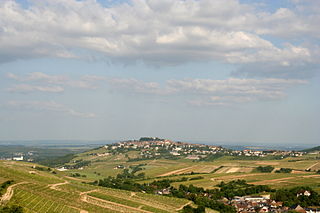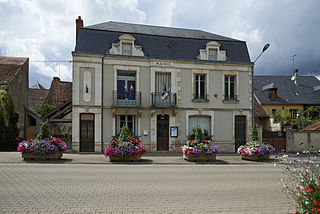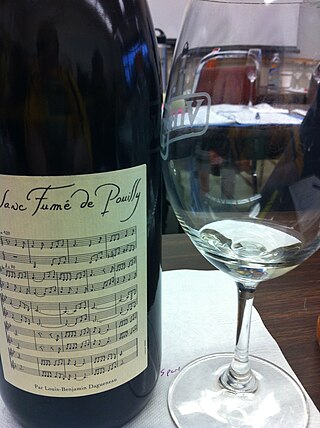
Graves is an important subregion of the Bordeaux wine region. Graves is situated on the left bank of the Garonne River, in the upstream part of the region, southeast of the city Bordeaux and stretches over 50 kilometres (31 mi). Graves is the only Bordeaux subregion which is famed for all three of Bordeaux' three main wine types—reds, dry whites and sweet wines—although red wines dominate the total production. Graves AOC is also the name of one Appellation d'origine contrôlée (AOC) which covers most, but not all of the Graves subregion.

Sancerre is a French wine Appellation d'origine contrôlée (AOC) for wine produced in the area of Sancerre in the eastern part of the Loire valley, southeast of Orléans. Almost all of the appellation lies on the left bank of the Loire, opposite Pouilly-Fumé. It is well regarded for and primarily associated with Sauvignon blanc. Some Pinot noir is also grown, accounting for around 20% of the region's production, making mostly light red wines under the designation of Sancerre Rouge. A rosé style from Pinot noir is also produced in a style similar to Beaujolais, which is produced from the Gamay grape.

Sancerre is a medieval hilltop town (ville) and commune in the Cher department, France overlooking the river Loire. It is noted for its wine.

French wine is produced all throughout France, in quantities between 50 and 60 million hectolitres per year, or 7–8 billion bottles. France is one of the largest wine producers in the world, along with Italian, Spanish, and American wine-producing regions. French wine traces its history to the 6th century BCE, with many of France's regions dating their wine-making history to Roman times. The wines produced range from expensive wines sold internationally to modest wines usually only seen within France such as the Margnat wines of the post war period.
Pineau d'Aunis is a red French wine grape variety that is grown primarily in the Loire Valley around Anjou and Touraine.

Ménétréol-sous-Sancerre is a commune in the Cher department in the Centre-Val de Loire region of France.

Pouilly-Fumé is an appellation d'origine contrôlée (AOC) for the dry sauvignon blanc white wine produced around Pouilly-sur-Loire, in the Nièvre département. Another white wine produced in the same area but with a different grape variety is called Pouilly-sur-Loire.

The wine regions of Bordeaux are a large number of wine growing areas, differing widely in size and sometimes overlapping, which lie within the overarching wine region of Bordeaux, centred on the city of Bordeaux and covering the whole area of the Gironde department of Aquitaine.

The Loire Valley wine region includes the French wine regions situated along the river Loire from the Muscadet region near the city of Nantes on the Atlantic coast to the region of Sancerre and Pouilly-Fumé just southeast of the city of Orléans in north central France. In between are the regions of Anjou wine, Saumur, Bourgueil, Chinon, and Vouvray. The Loire Valley itself follows the river through the Loire department to the river's origins in the Cévennes but the majority of the wine production takes place in the regions noted above. The area includes 87 appellations under the Appellation d'origine contrôlée (AOC) and Indication Géographique Protégée (IGP) systems. While the majority of production is white wine from the Chenin blanc, Sauvignon blanc and Melon de Bourgogne grapes, there are red wines made from Cabernet franc. In addition to still wines, rosé, sparkling and dessert wines are also produced. With Crémant production throughout the Loire, it is the second largest sparkling wine producer in France after Champagne. Among these different wine styles, Loire wines tend to exhibit characteristic fruitiness with fresh, crisp flavors-especially in their youth. The Loire Valley has a long history of winemaking dating back to the 1st century. In the High Middle Ages, the wines of the Loire Valley were the most esteemed wines in England and France, even more prized than those from Bordeaux.

In the Bordeaux wine region there are seven regional Appellations d'origine contrôlée (AOCs) that may be used throughout the Gironde department. These are Bordeaux Rouge AOC, Bordeaux Supérieur Rouge, Bordeaux Clairet, Bordeaux Rosé, Bordeaux Blanc, a dry white, Bordeaux Supérieur Blanc, a sweet white, and Crémant de Bordeaux, a sparkling méthode traditionnelle wine. The regional appellations together form the largest world-class wine vineyard, making up more than half of the production of the prestigious Bordeaux wine region, and representing more than 55% of all Bordeaux wines consumed in the world.
Menetou-Râtel is a commune in the Cher department in the Centre-Val de Loire region of France.
Parassy is a commune in the Cher department in the Centre-Val de Loire region of France.
Quantilly is a commune in the Cher department in the Centre-Val de Loire region of France.

Saint-Bris is an Appellation d'origine contrôlée (AOC) for white wine in the Burgundy wine region of France. This AOC is located around the village Saint-Bris-le-Vineux in the Yonne department, a few kilometers southwest of the Chablis AOC area, and southeast of the city of Auxerre, which places it roughly halfway between Paris and Burgundy's heartland in Côte d'Or. The approximately 100 hectares of vineyard in the appellation are situated in the communes Chitry, Irancy, Quenne, Saint-Bris-le-Vineux and Vincelottes.

Cour-Cheverny is a commune in the Loir-et-Cher department, Centre-Val de Loire region, France. The commune's land extends across the Loire Valley and across the Sologne region. Its inhabitants are known as Courchois.

Anjou wine is produced in the Loire Valley wine region of France near the city of Angers. The wines of region are often grouped together with the wines of nearby Saumur as "Anjou-Saumur". Along with the wines produced further east in Touraine, Anjou-Saumur make what is collectively known as the "Middle Loire" (as opposed to the "Upper Loire" which includes the wine regions of Sancerre and Pouilly-Fumé. Within the Anjou wine region are several Appellation d'origine contrôlées responsible for a broad spectrum of wines including still red, white and rosé produced with varying levels of sweetness. Extending across the Deux-Sèvres, Maine-et-Loire and Vienne départements, the generic Anjou AOC appellation and its various sub-appellations encompasses vineyards across more than 151 communes.

Touraine is an Appellation d'Origine Contrôlée (AOC) in the Loire Valley wine region in France that produce dry, white wines and red wines rich in tannins. The AOC status was awarded by a decree of December 24, 1939. The wine-growing area extends over 5,300 hectares departments of Indre-et-Loire, Indre and Loir-et-Cher and comprises a total of 70 communes and it is thus a "subregional" appellation covering the same area as a number of local AOCs.
Pouilly-sur-Loire is an Appellation d'Origine Contrôlée (AOC) for white wine in the Loire Valley region of France. It is specifically produced around Pouilly-sur-Loire in the Nièvre department and was awarded AOC status by a decree issued on 31 July 1937
Quincy is an Appellation d'origine contrôlée (AOC) in the Loire Valley wine region of France which produces dry white wine. It grows in two communes: Quincy and Brinay in the department of Cher.
Reuilly is an Appellation d'origine contrôlée (AOC) in the Loire Valley wine region of France, which takes its name from the Reuilly commune in the department of Indre, situated in the center of France.














